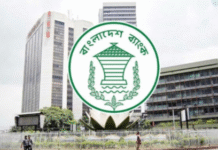
The World Bank has projected lower remittance growth for Bangladesh compared to that of India and Pakistan in 2021 due to the slower outmigration of workers who have returned home at the height of the global coronavirus pandemic.
The projection came in the Migration and Development Brief of the global lender published yesterday.
Bangladesh’s remittance receipts may stand at $23 billion this year, which is 4.54 per cent higher than in 2020.
Migrant workers sent home $18.88 billion in the first 10 months of 2021, up 7 per cent from $17.61 billion during the same period last year, Bangladesh Bank data showed.
In India, remittances are estimated to advance by 4.6 per cent to $87 billion, the WB report said. Pakistan will have another year of record remittances with growth at 26 per cent and levels reaching $33 billion.
Despite the slowing remittance flow, Bangladesh retained its position as the seventh highest recipient of the money transferred by migrant workers in the world. India will remain at the top and Pakistan at sixth.
China will come at second, Mexico third, the Philippines fourth, and Egypt at fifth.
“Bangladesh’s slowing growth in remittances in the first nine months of 2021 already suggests the downside risks for 2022, fueled mostly by the slow outmigration of returnee migrants, keeping remittances flat in the year,” said the WB.
“Although remittances rose above pre–Covid-19 and 2020 levels by almost 6 per cent to reach $23 billion in response to the government’s tax cuts and other incentives in 2021, the slowdown in growth is distinct.”
The forecast came as the deployment of workers from Bangladesh to the Gulf nations fell by 19 per cent year-on-year in the first three months of 2021.
Another hurdle to outmigration is the slow pace of visa issuance in the GCC countries.
Saudi Arabia granted 12 per cent fewer work visas in the first quarter of 2021 relative to the same period in 2020, while Oman reported a 15 per cent decline in Bangladeshi workers.
Following the outbreak of the coronavirus, many workers have returned home after losing jobs.
For example, the number of persons returned from Libya has doubled since 2020, according to the United Nations High Commissioner for Refugees. The majority are nationals of Sudan (17 per cent), Mali (11 per cent), and Bangladesh (11 per cent).
Malaysia has repatriated nearly 90,000 undocumented migrant workers to Bangladesh since November 2020 under an amnesty programme to either legalise or send such workers home.
Around 40,000 Bangladeshis who came home on vacation could not return this year, said the WB.
The GCC countries will require more skilled workers, but are likely to require fewer lower-skilled foreign workers in the future.
As at least 50 per cent of Bangladesh’s 5 million migrants in the GCC countries are less-skilled, the benefits of this win-win retooling strategy will be huge for the migrants and the government alike, said the WB.
Presently, the average monthly remittance of a Bangladeshi migrant who performs manual work is $203 compared to $276 for a Pakistani, $396 for an Indian, $564 for a Filipino, and $533 for a Chinese.
“The hike in remittances from more skilled Bangladeshi migrants could be a windfall for Bangladesh and its migrants,” said the report.
Migrants continue to pay exorbitant amounts to get jobs abroad, the report said, adding newly released data covering the 2019– 20 pre-pandemic period shows that Bangladeshi workers in Saudi Arabia paid the equivalent of 20 months of their foreign earnings, or around $5,000.
Remittance is an important pillar of the low-income countries and the dominant source of foreign exchange.
The significance of remittances ranged from about 13 per cent of gross domestic product for Pakistan to 6–8 per cent for Bangladesh and Sri Lanka, according to the WB.
The report says remittances to South Asia likely grew around 8 per cent to $159 billion in 2021. Higher oil prices aided economic recovery and drove the spike in remittances from the GCC countries, which employ over half of South Asia’s migrants.
South Asia has the lowest average costs of any region in the world at 4.6 per cent. But sending money to South Asia through official channels is expensive compared with informal channels that remain popular.
“Cost-reducing policies would create a win-win situation welcomed by migrants and South Asian governments alike,” said the WB.


 For all latest news, follow The Daily Star’s Google News channel.
For all latest news, follow The Daily Star’s Google News channel. 







